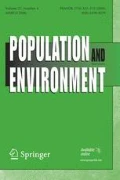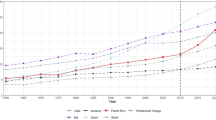Abstract
The UN's solicitousness for developed countries because of the possibility of their being depopulated seems disingenuous. In fact, developed countries are typically the losers from vast immigrant flows, and the underdeveloped countries that rid themselves of excess population are the gainers.
Similar content being viewed by others
REFERENCES
Abernethy, V., (1979). Population Pressure and Cultural Adjustment. New York: Human Sciences Press.
Abernethy, V. (1993 [1999]). Population Politics. New York: Plenum Press. Reprinted by Transaction Press, Piscataway, N.J.
Abernethy, V. D. (December, 1994). Optimism and Overpopulation, The Atlantic Monthly, 84–91.
Abernethy, V. D. (1996). Population theory and future population size. In B. Nath (Ed.). Environmental Pollution-ICEP3. London: European Centre for Pollution Research.
Abernethy, V. D. (1997). Allowing Fertility Decline: 200 Years After Malthus's Essay on Population. Environmental Law 27(4), 1097–1110.
Abernethy, V. D. (1999). Family Formation in America. Chronicles, May, pp. 13–16.
Bartlett, A. A. Population Growth: Obstacle to Meeting Kyoto Target. Population and Environment 20 (4), 387–388.
Camarota, S. A. (1999). Immigrants in the United States—1998. Center for Immigration Studies, Washington, D.C.
Duncan, R. C., & Youngquist, W. (1999). Encirclingk the Peak of World Oil Production. Natural Resources Research 8 (3), 219–232.
Easterlin, R. 1962. The American Baby Boom in Historical Perspective. Occasional Paper #79. N.Y: National Bureau of Economic Research.
Easterlin, R., “Does Human Fertility Adjust to the Environment?” American Economic Review 61(2), 399–407, 1971.
Easterlin, R. 1976. Population change and farm settlement in the Northern United States. Journal of Economic History 36, 45–75.
Hegstrom, E. (June 16, 2000). Mexico's Opposition Candidate Favors Free Flow for Migrants. Houston Chronicle.
LeDuff, C. (June 16, 2000). At a Slaughterhouse, Some Things Never Die. New York Times, pp. A1, 22–23.
Lee, R. D. (November, 1987). Population Dynamics of Humans and Other Animals. Demography, 24 (4) 443–465.
Lee, R. D. (1980). A Historical Perspective on Economic Aspects of the Population Explosion: The Case of Pre-Industrial England. Population and Economic Change in Developing Countries, pp. 517–556. R. E. Easterlin (Ed.). Chicago: University of Chicago Press.
Macunovich, D. (1999). The Role of Cohort Size and Relative Income in the Demographic Transition. Population and Environment 21(2), 155–192.
Matlof, N. (1995). Debuzzing immigration. National Review, Oct. 9.
Matloff, N. (June 5, 1998).Visa Program for High-Tech Workers. Wall Street Journal, Letters.
National Research Council (1997). The New Americans. Washington, D.C: National Academy of Sciences Press.
Pimentel, D., Giampietro, M., & Bukkens, S.G.F. (1998). An Optimum Population for North and South America. Population and Environment 20 (2), 125–148.
Skocpol, T., & Leone, R. C. (2000). The Missing Middle: Working Families and the Future of American Social Policy. New York: Norton and Co.
Social Security and the Future of U.S. Fertility (1997). Documents. Population and Development Review 23 (1), 208–213.
Ventura, S., Martin, J. A., Mathews, T.J., & Clarke, S. C. (June, 1996). Advance Report of Final Natality Statistics, 1994. Supplement 44 (11), Tables 10 & 11 (pp. 41–42). National Center for Health Statistics, Division of Vital Statistics.
Ventura S.J., Martin, J.A., Curtin, S.C. & Mathews, T.J. (1999). Births: Final Data for 1997. National Vital Statistics Reports, 47(18, April 29, 1999), National Center for Health Statistics, U.S. Department of Health and Human Services: Washington, DC.
Youngquist, W. (2000). Personal communication.
Author information
Authors and Affiliations
Rights and permissions
About this article
Cite this article
Abernethy, V.D. Comment on Bermingham's Summary of the U.N.'s Year 2000 Replacement Migration, Is it a Solution to Declining Population and Aging?. Population and Environment 22, 365–375 (2001). https://doi.org/10.1023/A:1006741420885
Issue Date:
DOI: https://doi.org/10.1023/A:1006741420885




